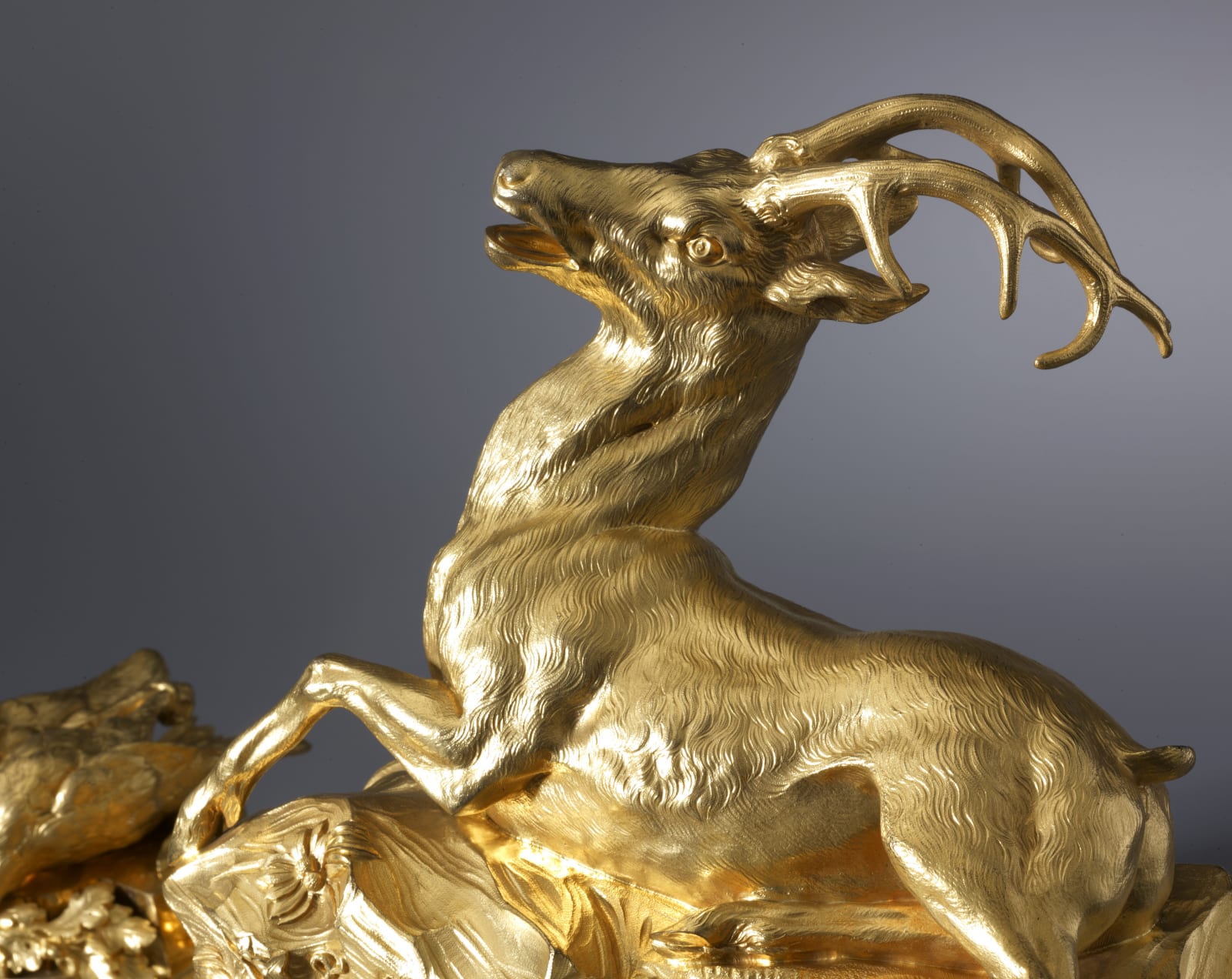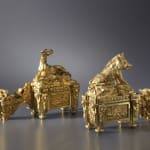Alfred Beurdeley Père (attributed to)
Literature
F. J. B. Watson, "The Wrightsman Collection", 1966, vol. II, no. 199, pp. 382-385, illustrating and describing an almost identical earlier version by Quentin-Claude Pitoin now in the Wrightsman Collection. Daniel Alcouffe, Anne Dion-Tenenbaum, and Gérard Mabille, "Gilt Bronzes in the Louvre", 2004, pp. 118-120, no. 55, illustrating and describing an almost identical pair of chenets by Quentin-Claude Pitoin, 1772, on which the present pair are based.
An extremely fine pair of Louis XVI style gilt bronze chenets attributed to Alfred Beurdeley Père after a pair by Quentin-Claude Pitoin, each with a substantial rectangular plinth supported on toupie feet adorned at the corners with projections bearing dog hides, the entablature with oak leaf rosettes and intertwined ivy branches with a bas-relief showing game in a landscape, above the left hand plinth is a crouching wild boar and to the right a stag, both at bay and on a rocky base, both with projecting extensions terminated by a fluted column, the whole adorned with rosettes, laurel and ivy wreaths, surmounted by oak branches and dead game
Height of the chenet with stag: 38.5 cm, height of the chenet with wild boar: 41 cm,
length of both 47 cm.
Paris, date circa 1860
These imposing chenets, attributed to Beurdeley are later models of the celebrated pair made by the doreur du Roi Quentin-Claude Pitoin (b. circa 1725 d. 1777) which were delivered in 1772 to Madame du Barry and are now in the Musée du Louvre, Paris. When her property the Pavillon de Louveciennes was assessed by Riesener, Julliot and Lignereux, acting as government commissioners, in January 1795, her chenets were valued at 9,000 livres. Pitoin subsequently created other pairs including one with slightly longer extensions reputedly made for the comte de Vergennes, Louis XVI's foreign minister from 1774 until his death in 1787. That pair is now in the Wrightsman Collection, Metropolitan Museum, New York. Another set, which were used in Louis XVI's library at Versailles was sold in 1793 while a fourth pair were installed in Marie-Antoinette's games room at Compiègne. Those chenets were at one time attributed to Pierre Gouthière, however based on Pierre Verlet's research (outlined in 'The Burlington Magazine', June 1950, p. 155), it is now accepted that they were in fact made by Pitoin, who though less known was nevertheless equally skilled. The model for the boar was based on a bronze cast made by the Italian sculptor Francesco Susini (d. 1646) in the Mercato Nouvo in Florence, of which small reproductions were cast such as one now in the Victoria and Albert Museum, London.
A number of later repetitions of Madame du Barry's chenets were made during the nineteenth century of which one pair is in the Musée des Arts Décoratifs, Paris. Among later bronziers responsible for such versions were Lucien-François Feuchère, Bagues as well as Beurdeley. The latter excelled at copying Louis XV and Louis XVI furniture and bronzes having been given access by the Garde-Meuble to the collections at Versailles, the Petit and Grande Trianons and the Louvre where they were allowed to make moulds and replicas of 18th century furnishings and bronzes. Such copies were greatly praised by the critics for the quality of their craftsmanship and by wealthy collectors such as the Rothschilds, who were keen to recreate 18th century interiors. The 19th century witnessed a great revival of past historical styles but due to the inevitable shortage of original works, Beurdeley and others met the demand by recreating high quality revival pieces, whose quality was often indistinguishable from earlier prototypes.
The famous Beurdeley dynasty began with Jean Beurdeley (1772-1853) and was continued by his son Alfred Beurdeley père (1808-82) and then grandson Alfred Beurdeley fils (1847-1919). After serving in the Napoleonic army, Jean opened a small antique shop in the Paris Marais district and in 1830 bought the Pavillon de Hanovre, 28 Blvd. des Italiens, which was to be the firm's principal gallery until 1894. The business was expanded by his son Alfred Beurdeley père, who continued dealing in antiques and works of art and as a supreme ébéniste specialised in reproductions of 17th and 18th century furniture and bronzes. His clients included Napoleon III and the Empress Eugénie. He was first assisted and then succeeded by his illegitimate son Alfred Beurdeley fils, who took over the workshop in 1875 until his retirement twenty years later.
The latter tended to specialise in luxury 18th century style furniture and bronzes and as one of the finest manufacturers of his day was awarded a gold medal at the Paris Exposition Universelle in 1878 and in 1893 was appointed a Chevalier de la Légion d'Honneur. The death of his wife in childbirth 1894 resulted in a dramatic change of direction. In 1875 Beurdeley retired; he closed down the Pavillon de Hanovre and began selling his vast stock of furniture and bronzes in a series of sales, 1895-1900. He also sold his impressive collection of 18th century French drawings in 1905, a fine collection of architectural drawings to the Stieglitz Museum and an enormous collection of Chinese porcelain in 1906 and spent his remaining years in pursuit of fine French 19th century drawings.



